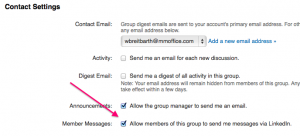Okay. So you connected with or are in a group  with someone on LinkedIn, and in your opinion the person hasn't been acting professionally.
with someone on LinkedIn, and in your opinion the person hasn't been acting professionally.
Now what?
If someone in your network has committed an unpardonable faux pas, here are some steps you can take to address the situation.
1. Someone sent you a spammy email shortly after you agreed to connect on LinkedIn.
Unless you're fairly certain this connection could or should lead to something positive, I'd suggest you disconnect in a hurry.
There are two ways to  remove a person from your network. First, you can click Remove Connection right on his profile. However, your name will then appear on his Who's Viewed Your Profile list.
remove a person from your network. First, you can click Remove Connection right on his profile. However, your name will then appear on his Who's Viewed Your Profile list.
You can also go to your Connections tab on the top toolbar, put his name in the Search box, and select More>Remove connection when his entry is displayed.
2. One of your connections sends you way too many direct messages, and they're usually about subjects you have no interest in.
If the person is a valued connection, I'd politely ask her to take you off of her email campaign list in the future. If the problem persists, consider removing her from your network.
3. The person sending too many irrelevant direct messages  is not directly connected to you, but you're in the same LinkedIn group.
is not directly connected to you, but you're in the same LinkedIn group.
If the group provides relevant information and good relationships for you, you can either politely ask the person to stop sending you direct messages or you can go to the Settings tab in that group and uncheck Allow members of this group to send me messages via LinkedIn. However, then you won't be able to receive direct messages from anyone in the group.
4. A person in your network posts too many status updates, and they're usually irrelevant or downright silly. However, you don't want to disconnect with him because you think it will be a beneficial relationship.
The next time you see a status update from him, slide over to the top right of the status update and click the word "Hide." Then his status updates will no longer appear in your feed.
5. A friend calls you and says one of your LinkedIn connections is driving her crazy. The guy refers to your friendship in his unending phone messages, and she's just not interested in what he's selling.
First, ask him to stop contacting your LinkedIn connections and dropping your name without your permission. Secondly, you may want to consider hiding your first-level connections from your network. But before you take this step, be sure you understand the ramifications of this important decision. I discuss the pros and cons in my article "Should You Hide Your LinkedIn Connections?"
If these scenarios are popping up frequently, maybe it's time to revisit your overall LinkedIn connections strategy. For help with this, check out my article "The LinkedIn Connection Conundrum: Who Should Be In Your Network?"


